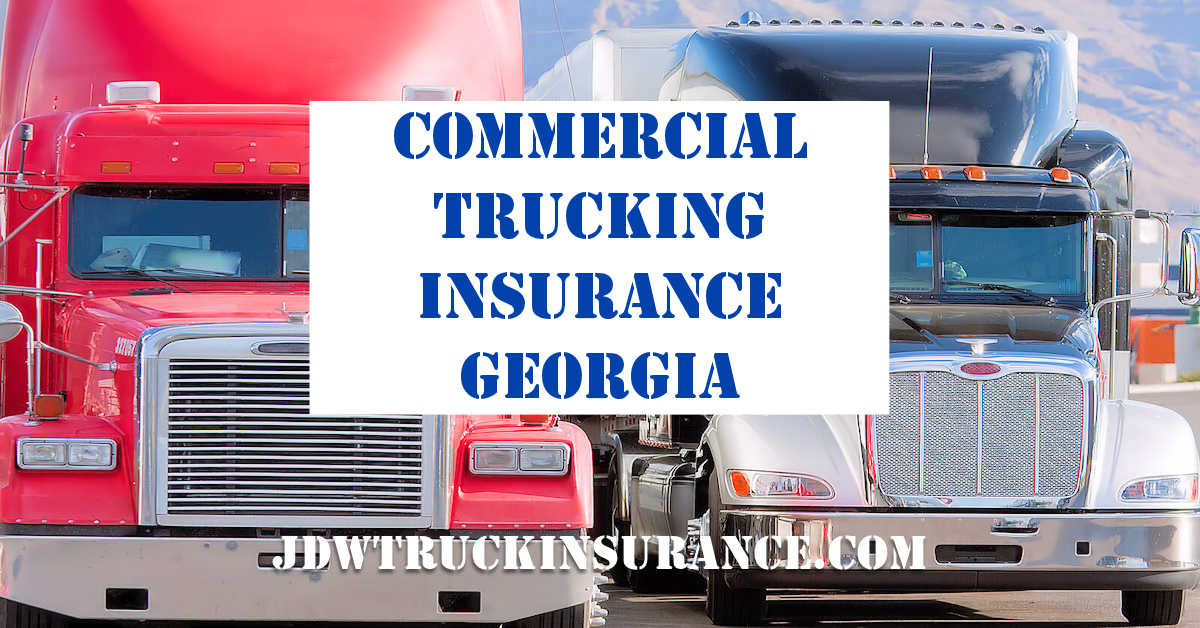Owner Operator Truck Truck Insurance Maysville, Georgia
New Authority Truck Insurance Georgia
Commercial truck insurance Georgia. Owner Operator Truck Truck Insurance Maysville, Georgia. Affordable commercial truck insurance GA. Top rated commercial truck insurance companies Georgia.
Owner Operator Truck Truck Insurance Maysville, Georgia
If you are searching for New Authority Truck Insurance Georgia. JDW Truckers Insurance specializes in New Authority Truck Insurance in Georgia. We help you get affordable commercial insurance rates for your new authority.
We offer quote from only the top rated commercial truck insurance companies who offer the best rates for your new authority in Georgia.
JDW will help get the the correct commercial truck insurance in place which will fit your budget and allow you to haul the cargo you want and need to in order to be successful.
We are here to answer your questions with fast and friendly service.
Owner Operator Truck Truck Insurance Maysville, Georgia
We offer affordable new authority trucking insurance for the entire state of Georgia.
We Customize your New Authority Truck Insurance to Help you Save Money!
Our agents at JDW Truckers Insurance know trucking insurance in Georgia. We will explain the different options and commercial truck insurance requirements in Georgia.
We help you get the right coverages in place so you are no over paying for coverages you may not need. We also help you make sure you have the coverages you need in place. And we do this at affordable commercial truck insurance rates.
New Authority Truck Insurance Requirements and Options
General Liability Insurance for Truckers
- General liability insurance for truckers should not be confused with primary liability for truckers.
- Similar to primary liability. General liability offers coverages to pay for physical damage to other and/or bodily injury to others. BUT there is a difference between the two.
- For example, if you are loading or unloading and you cause injury to someone or their property this is when the general liability policy would respond.
- The actions of a driver while representing the insured and on the premises of others, such as loading docks and truck stops
- General Liability is normally offered $1,000,00 per occurrence and $2,000,00 aggregate. What does this mean?
- It the insurance company will pay up to $1,000,000 for any one claim and no more than $2,000,000 per year for the total of all claims.
- General liability can be required by shippers and other companies such as the UIIA and flatbed operations.
- If there is any chance you might be involved in loading or unloading. General Liability is relatively inexpensive and is an advised coverage.
Auto Liability Insurance
- Your Auto Liability or primary liability will be the major cost for your trucking insurance policy. Although the FMCAS can only require $750,000 in most cases shippers will require $1,000,000 in primary liability insurance coverage before they will allow you to pick up loads.
- Primary liability insurance covers damages to third parties for bodily injury and physical damage to others property in the event of an accident.
Medical Pay
- In most cases this is a low cost add on to your primary liability insurance to cover medical expenses.
PIP – Personal Injury Protection
- Some states require this coverage and, in many cases, can reduce the need for Medical Pay.
- Personal injury protection (PIP), also known as no-fault insurance, covers medical expenses and lost wages of you and your passengers if you’re injured in an accident. PIP coverage protects you regardless of who is at fault.
Uninsured Motorist
- If you’re hit by a driver with no insurance…
- Uninsured motorist bodily injury (UMBI) may pay medical bills for both you and your passengers.
- Uninsured motorist property damage (UMPD) may pay for damage to your vehicle.
Underinsured Motorist
- If you’re hit by a driver with not enough insurance…
- Underinsured motorist bodily injury (UIMBI) may pay medical bills for both you and your passengers
- Underinsured motorist property damage (UIMPD) may pay for damage to your vehicle
Motor Truck Cargo
- MTC or Cargo insurance provides insurance on the freight or commodity hauled by a for-hire trucker. It covers your liability for cargo that is lost or damaged due to causes like fire, collision or striking of a load.
- If your load is accidentally dumped on a roadway or waterway, some cargo forms offer Removal Expenses coverage pays for removing debris or extracting pollutants caused by the debris. And can also pay for costs related to preventing further loss to damaged cargo through Sue and Labor Coverage and legal expenses in the defense or settlement of claims. Another option is Earned Freight Coverage to cover freight charges the customer loses because of an undelivered load.
- Cargo insurance deductibles can be set at $1,000, $2,500, $5,00 or even higher if you are self-insured.
- Cargo coverage limits are normally set at $100,00 but some shippers may have higher requirements depending on the cargo you are hauling.
- Cargo policies can have exclusions stating what cargo it will or will not cover.
Trucking Physical Damage Insurance (PD)
- Physical damage insurance coverages are designed to pay for losses to your equipment and damages to others equipment. (Others equipment must be listed on your policy).
- If you own or lease equipment. You may be required to have PD by bank or leasing company to carry a set amount of physical damage insurance and name them as a Loss Payee.
- PD can also cover damage to others equipment you are in possession of if the coverage is listed on your policy. An example would be non-owned trailer insurance coverage.
- Deductibles for physical damage range from $1,000 to $5,000.
- Required deductibles. If you have a loan on your equipment or it is leased. They bank or leasing company may have a minimum deductible you can have on your physical damage policy.
Owner Operator Truck Truck Insurance Maysville, Georgia
Chat with JDW Truckers Insurance. We are fast and friendly. Great customer service. Free 24/7 COI.
We offer affordable new authority truck insurance in:
AL – AR – FL – GA – IN – MO – MS – NC – OH – PA – SC – TN – TX – VA
We offer new authority truck insurance quotes for:
- Dry van
- Flatbed
- UIIA
- Amazon
- Reefer and more
Owner Operator Truck Truck Insurance Maysville, Georgia
Owner Operator Truck Truck Insurance Maysville, Georgia
Maysville is a town in Banks and Jackson counties in the U.S. state of Georgia. The population was 1,798 at the 2010 census, up from 1,247 at the 2000 census.
The Georgia General Assembly incorporated Maysville as a town in 1879.
According to the United States Census Bureau, the town has a total area of 4.3 square miles (11.2 km), of which 4.2 square miles (11.0 km2) is land and 0.04 square miles (0.1 km), or 1.27%, is water.
Maysville is 70 miles (110 km) northeast of Atlanta. Towns within 10 miles (16 km) include Commerce, Gillsville, Lula, Jefferson, and Pendergrass.
Maysville has a humid subtropical climate. The temperature peaks in July with an average high of 90°, but temperatures can get much colder during the winter months. The average low during January was 29°.
Maysville has even seen fair amounts of heavier than average snowfall in the past. An example of this occurred in March 2009 when several inches of snow fell across Banks County.
The governing legislative authority has two components. A mayor serves as the top executive along with four city council members. The head of the local government is Mayor Richard Presley.
The legislative council serves as governing head, in conjunction with the mayor, over Maysville and its issues. it was established in March 2010 by House Bill 961.
“The members of the city council shall serve for terms of four years and until the respective successors are elected and qualified. The term of office of each member of the city council shall begin on the first day of January immediately following the election of such member unless general law authorizes or requires the term to begin at the first organizational meeting in January or upon some other date. No person shall be eligible to serve as mayor or councilmember unless that person shall have been a resident of the city for 12 months prior to the date of the election of mayor or members of the city council; each shall continue to reside therein during that person´s period of service and to be registered and qualified to vote in municipal elections of this city.The mayor and councilmembers shall be elected by plurality vote as provided in Section 5.13 of this charter.”
The city council holds an organizational meeting on the first Monday of January following each election. The meeting is called to order by the city clerk and the oath of office is administered to the newly elected members.
Special meetings of the city council may be held should the mayor request them. All councilmembers must be notified personally, or by telephone, at least 48 hours in advance of the meeting.
Maysville is apportioned into four voting wards. Members from the city’s council are elected into representing each assigned ward during council meetings.
As of the census of 2010, there were 1,798 people, 669 households, and 493 families residing in the town. There were 756 housing units, of which 87, or 11.5%, were vacant. The racial makeup of the city was 93.8% white, 2.2% African American, 0.4% Asian, 1.1% some other race, and 2.4% from two or more races. 2.6% of the population were Hispanic or Latino of any race.
Of the 669 households, 35.9% had children under the age of 18 living with them, 58.7% were headed by married couples living together, 10.6% had a female householder with no husband present, and 26.3% were non-families. 24.1% of all households were made up of individuals, and 12.1% were someone living alone who was 65 years of age or older. The average household size was 2.66, and the average family size was 3.13.
In the town, 25.4% of the population were under the age of 18, 7.9% were from 18 to 24, 26.5% from 25 to 44, 26.7% from 45 to 64, and 13.5% were 65 years of age or older. The median age was 38.4 years. For every 100 females, there were 92.7 males. For every 100 females age 18 and over, there were 88.3 males.
For the period 2012–2016, the estimated median annual income for a household was $37,714, and the median income for a family was $40,313. The per capita income for the town was $18,105. Male full-time workers had a median income of $40,313, versus $33,438 for females. 21.5% of the population and 23.3% of families were below the poverty line. 23.7% of the population under the age of 18 and 14.7% of those 65 or older were living in poverty.
As of the census of 2000, there were 1,247 people, 481 households, and 365 families residing in the town. The population density was 346.1 inhabitants per square mile (133.6/km2). There were 529 housing units at an average density of 146.8 per square mile (56.7/km). The racial makeup of the town was 95.11% White, 2.57% African American, 0.08% Native American, 0.24% Asian, 0.96% from other races, and 1.04% from two or more races. Hispanic or Latino people of any race were 1.52% of the population.
There were 481 households, out of which 35.8% had children under the age of 18 living with them, 61.7% were married couples living together, 9.6% had a female householder with no husband present, and 24.1% were non-families. 21.6% of all households were made up of individuals, and 8.9% had someone living alone who was 65 years of age or older. The average household size was 2.58 and the average family size was 2.99.
In the town, the population was spread out, with 26.3% under the age of 18, 6.9% from 18 to 24, 32.7% from 25 to 44, 22.5% from 45 to 64, and 11.5% who were 65 years of age or older. The median age was 36 years. For every 100 females, there were 93.6 males. For every 100 females age 18 and over, there were 85.3 males.
The median income for a household in the town was $40,714, and the median income for a family was $47,368. Males had a median income of $34,063 versus $24,615 for females. The per capita income for the town was $17,153. About 4.5% of families and 6.6% of the population were below the poverty line, including 3.6% of those under age 18 and 21.4% of those age 65 or over.
The portion in Banks County is in the Banks County School District. Students there are zoned to Banks County High School.
The portion in Jackson County is in the Jackson County School District.
Choose the Right Agent
When choosing the agent, you want to represent you to the insurance companies. Pick an agent that is trained in commercial truck insurance. And make sure the agent you choose to work with is there when you need them. Our agents are trained in commercial truck insurance and are easy to contact. Email, phone call or text message. We respond quickly to our clients.
Certificate of Insurance
Not being able to get a quick COI could cost you money by not being able to pick up a load for the lack of a COI. Our clients at JDW Truckers Insurance are given access to our COI Portal where they can issue a COI 24/7 free of charge.
Insurance Companies Customer Service
Not only should you choose a responsive agent but you will want to be insured by a commercial insurance company who also responds to your requests and are there to help you in case of a claim or endorsements
AM Best Ratings
The AM Best Rating of the commercial truck insurance company you choose to insure your operation should not be over looked. You want to be insured by a trucking insurance company that has the financial stability to pay claims. Many shippers will require an AM Best Rating of A – minus of better. At JDW all of network of commercial truck insurance companies have an AM Best Rating of A – or better.



